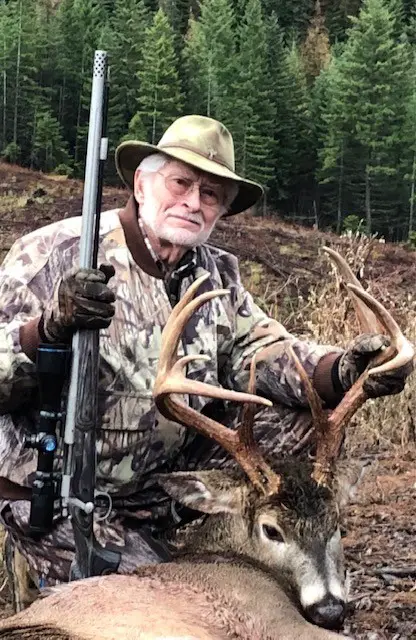|
By Bob Parker Through the years the quest for the “Perfect” hunting bullet has challenged the best of bullet makers. All that is required of these projectiles is that they will open (deform), hold together, create a sizable wound channel, give tissue disruption that is capable of a quick, humane harvest. Whether it is at 100 yards or if the shot happens to be 500 yards…we simply want the same outcome. All this is at muzzle velocities that may range from 1900 fps (3 pellet arena) to 2800 fps or so, if you happen to shoot a custom smokeless rifle. I realize these are two extremes and most of us fall somewhere in between, most likely on the lower end of 1900-2500 fps. The centerfire industry has addressed this issue by developing a number of specialized projectiles designed to do a specific job. Examples include bonded bullets, partitioned bullets, solids, tapered jackets, target and thin jacket varmint bullets. This same application, however, does not apply exactly into the muzzleloading world. If
you shoot a rifle with sabots you can use some centerfire bullets
(often low B.C. pistol), but when it comes to bullet to bore it is a
different circumstance. Most bullet to bore rifles use a land riding
approach and depend on the initial pressure spike to shorten and
belly out the bullet causing the projectile to engage the rifling,
producing stabilization and accuracy. This is more difficult with
thicker jacketed centerfire bullets. Herein
lies the dilemma, the target shooter wants a thin jacket
(.015-.021), as this projectile loads easy, obturates quickly, does
not require heavy powder charges, delivers low recoil and usually
shoots very well. However, if you take this same bullet loaded to
hunting velocities and slam it into the shoulder of an Elk, Moose,
Brown Bear, Cape Buffalo and Oryx or Eland, disappointment will more
than likely follow. The hunting bullet must have some of the same characteristics as the target bullet, it must obturate and stabilize (sometimes not easy with comfortable target loads), it must be accurate, have a B.C. that allows for easier long range applications and it must have a terminal effect that gives a clean harvest, even at long range. This is not an easy job description. If you are a “whitetail hunter only”, it is not as difficult, as your regular bullet used for paper will often do just fine. But if your game is larger, tougher and has the potential of danger to your person, a bullet that fragments on a shoulder is the last thing you want on your hunt. At Parker Productions we have chosen to address this issue in the following manner. We do not take a “One Bullet Does All” approach. Rather, we have tailored our bullets for the total velocity, game, distance, terrain, application situation. If you should call Bob Parker (208-596-8430), I will more than likely ask you these questions. What game are you hunting? What rifle do you shoot? What are your hunting conditions and terrain? Finally, how far are your shots? Then I try to answer the questions at hand. When it comes to application, we place bullets in three categories:
When you place bullets and categories together, it is as follows: 1. The standard muzzleloader will produce the best result with our Ballistic Extreme bullet line. They carry a lighter jacket that allows good expansion at standard velocity and they are sabot friendly. If you hunt is for Elk, Moose or other large game the 300gr Ballistic Extreme performs very well. When these projectiles are used in the high velocity custom builds, the will shoot very accurately. However, extremely dramatic expansion will result. 2. Mid-Velocity Muzzleloaders, this includes the Savage, Remington Ultimate, custom Blackhorn builds and various other custom designs. The projectiles developed especially for these rifles is the Black Max. It is well suited for both sabot and bullet to bore applications. They will open at 1600 fps and perform well at higher velocities. They are big game bullets designed for a “behind the shoulder” hold, however with the heavier weights (300 grain and 327 grain) if you are off a bit they will still do well. 3. When we come to the high velocity custom weapons (up to 3000 fps) the Match/Hunter is the recommended projectile. It will perform well at these velocities and is very effective on North America’s largest and toughest game. The Match/Hunter is primarily a “High Shoulder Shot” bullet and when this application is practiced a clean harvest can be expected.  Bob Parker (above) can be found, when not chasing his wife or eating ice cream, at https://parkerproductionsinc.com/ . |